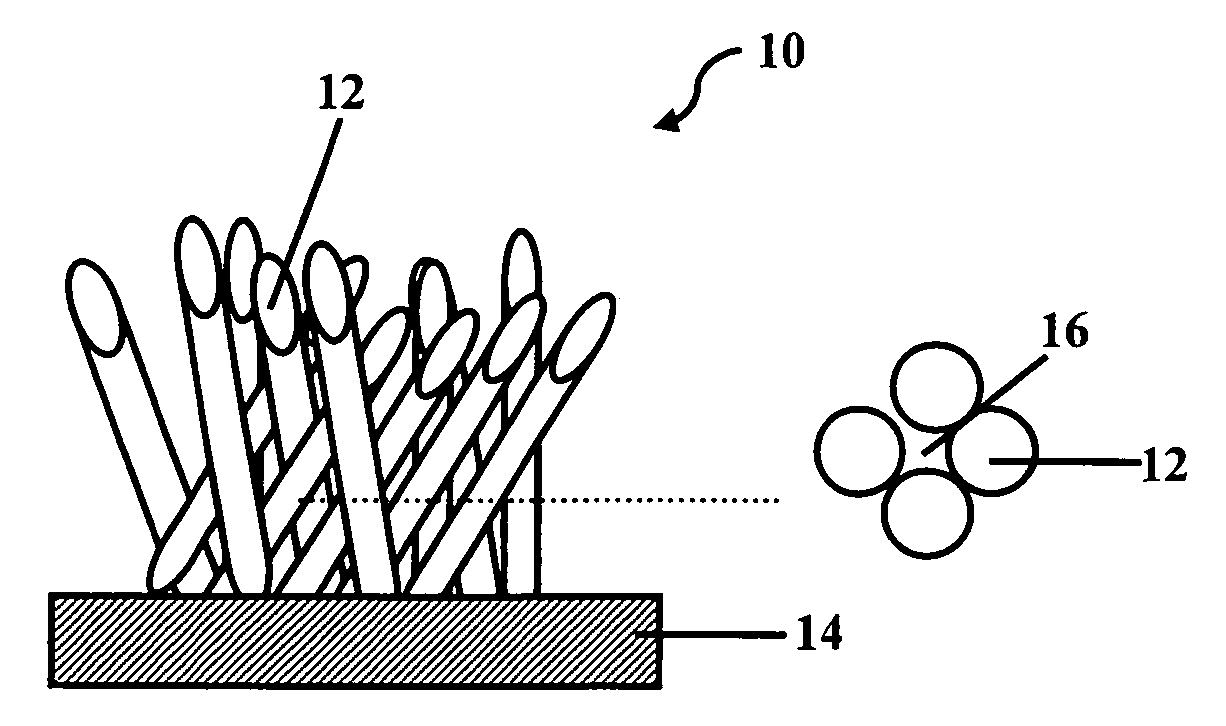Nano-sized needle crystal mullite film and method of making
a crystal mullite film, needle-like technology, applied in the direction of silicates, ceramics, membranes, etc., can solve the problems of crystal structure, high sintering rate, and difficulty in achieving high stability and permeability using these materials
- Summary
- Abstract
- Description
- Claims
- Application Information
AI Technical Summary
Benefits of technology
Problems solved by technology
Method used
Image
Examples
example 1
[0066]A sol was made with anhydrous AlCl3, tetraethoxysilane (TEOS), ammonium tungstate and de-ionized water, in a molar ratio of 16:4:1:55, respectively. AlCl3 is the precursor for Al. Although AlCl3 was used in this preparation, aluminum alkoxide having the formula Al(OR)3, wherein R is a carbon chain of 1 to 8 carbon atoms can also be used. R may be either straight or branched. Examples of such alkoxides are methoxide, ethoxide, isopropoxide, propoxide, butoxide, isobutoxide, amyloxide, hexoxide, octoxide, 2-ethyl-butoxide, 2-ethyl-hexoxide and the like. The preferred alkoxide is aluminum isopropoxide.
[0067]TEOS is the precursor for Si. Although TEOS was used in this preparation, silicon (Si) precursors which are organic silicon compounds which can be hydrolyzed in the solution, for example compounds comprising silane may also be used.
[0068]Ammonium tungstate is an additive (catalyst) to facilitate the formation of needle-like crystals. Although ammonium tungstate was used in thi...
example 2
[0075]Three sols of different Al / Si / W ratios were made with the AlCl3, tetraethoxysilane (TEOS), ammonium tungstate and de-ionized water. Sol#1, sol#2 and sol#3 were prepared in which the molar ratios of Al / Si / W were 4 / 1 / 0.25, 4 / 1 / 0, and 3 / 2 / 0.25, respectively. The sols were prepared using the same procedure and conditions as used in Example 1. The resulting sols were used to coat channel walls of a mullite monolith support structure with a channel diameter of 1.8 mm by a dip coating technique. The coated support structures were dried and calcined in the same tubular furnace in 100 standard cubic centimeters (sccm) of air flow with the following temperature profile: raise the temperature from room temperature to 60° C. at 2° C. / minute, hold for 5 hours at 60° C., ramp to 120° C. at 2° C. / minute, hold for 10 hours at 120° C., ramp to 900° C. at 2° C. / minute, hold for 6 hours at 900° C., cool down at 2° C. / min to 20° C. SEM analysis of the sol#1 calcined at 900° C. is shown in FIG. 5A...
example 3
[0076]The three sols, sol#1, sol#2 and sol#3, having the same Al / Si / W ratios, respectively, as those in Example 2 were prepared and left under ambient conditions for approximately one week to form a gel. The resulting gels were dried, calcined and heated in the same manner as Example 2 to form a bulk material. FIG. 6A, FIG. 6C and FIG. 6E show the texture of the calcined and heated powder. It is difficult to assess differences in the microstructure among the three samples after calcination at 900° C. However, distinctive features are apparent after the calcined sample was further heated at approximately 1200° C. Needle or whisker-like crystals start emerging in the powder material derived from the sol#1 shown in FIG. 6B and the sol#3 shown in FIG. 6F. By contrast, the bulk powder material shown in FIG. 6D derived from the sol#2 does not show the same needle-like crystals even after further heated at approximately 1200° C. This example shows that the presence of the W catalyst in the...
PUM
| Property | Measurement | Unit |
|---|---|---|
| temperature | aaaaa | aaaaa |
| temperature | aaaaa | aaaaa |
| temperature | aaaaa | aaaaa |
Abstract
Description
Claims
Application Information
 Login to View More
Login to View More - R&D
- Intellectual Property
- Life Sciences
- Materials
- Tech Scout
- Unparalleled Data Quality
- Higher Quality Content
- 60% Fewer Hallucinations
Browse by: Latest US Patents, China's latest patents, Technical Efficacy Thesaurus, Application Domain, Technology Topic, Popular Technical Reports.
© 2025 PatSnap. All rights reserved.Legal|Privacy policy|Modern Slavery Act Transparency Statement|Sitemap|About US| Contact US: help@patsnap.com



